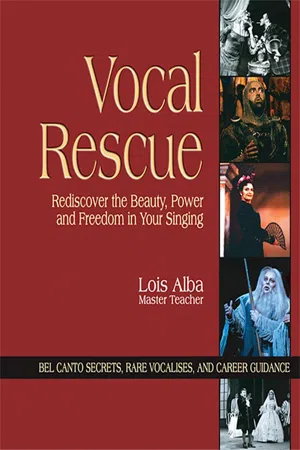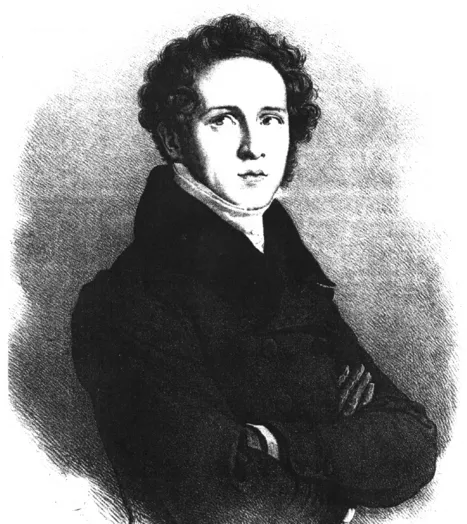![]()
Part 1
THE SECRETS TO BEAUTIFUL SINGING
![]()
Introduction to The Secrets to Beautiful Singing (Bel Canto)
Vincenzo Bellini
Master composer of bel canto operas (1801 – 1835)
![]()
Breathing
Breath Support
Breath is the life of the sound. Thus, “breath support” is the first principle all singers need to understand. Many “methods” that are given for arriving at the “support” of the breath, however, are both confusing and cause great rigidity in the body.
The breath should never be held back.
Lilii Lehmann
In fact, “support” has become a subject of great controversy. It does not mean HOLD OUT, DRIVE OUT, or PUSH PIANOS, books, or other heavy objects. To support the breath means, simply, to be conscious of the inhalation in a gentle manner and mentally sustain the sound by consciously emitting the minimum without strong pressure. It can be likened to sighing out the air.
To understand how breath supports the tone, observe something a bit more solid than airy breath: Watch how water follows the path of least resistance. A stream flows over rocks and around curves and over waterfalls. What supports it? It is not forced out of some giant hose. Rather, the natural forces of gravity that result from the Earth turning regularly on its axis (much like natural breathing) cause it to flow. If a dam is erected, however, this flow is blocked.
Breath supports tone in much the same way—natural breathing allows tone to follow the path of least resistance—IF it is not blocked by tense breathing, rigid bodies, tight lips, exaggerated vowels, and other misguided, “death-defying” attempts at SUPPORT!
Rosa Ponselle told me she felt as if her voice were on a tray. This is another good image of the sensation of the tone being easily supported.
As the brilliant coloratura Luisa Tetrazzini observed, “Certain young singers take in an enormous breath, stiffening every muscle in order to hold the air, thus depriving their muscles of all elasticity … Too much in-breathing and too violent an effort in inhaling will not help the singer at all. The attack of the sound must come from the appoggio, or breath prop.”* To simplify this concept, think of the breath issuing from the lungs supporting the tone; the feeling is of leaning on the breath. This is appoggio.
Mio Dio. If God has not taught you how to breathe, it is time you were buried.
Vincenzo Cirillo (1623 – 1667) from Il Bel Canto, by Vittorio Ricci
Herbert Caesari made a similar observation: “Mediocrity invariably employs a blind, uncontrolled, and uncompromising maximum breath pressure; quality singers use a perfectly controlled indispensable minimum.”†
Posture
Posture is often said to be the cure-all for support, but this doesn’t mean a military stance, that is, rigid chest, held high, and very often the knees are locked. The ideal stance is one that offers easy balance and the feeling that the feet, legs, and torso support the body, leaving the lungs and throat free to act.
Once you have the right posture, movement about the stage will be more natural also.
Here are two images that can be used as exercises in posture:
The first is from a wonderful teacher, Bettye Gardner, with whom I studied movement. In addition to being a fine teacher of singing, she had also been a dancer, having studied with José Limon. She used much imagery in her teaching and this was her main expression:
The singer or actor must have the feeling of “tearing down” or “moving through” space. The desire to move through space with a strong impetus gives the body a sense of directed energy. Posture improves immediately and yet there is no stiffness.
This is the second image I find helpful:
Imagine having a string attached to the chest and being pulled forward by it. It is very easy to identify singers who move with this sense of focus.
Ease of Breath
Singing is an activity of the whole body. The energy is generated through the inhalation of breath. It is the life of the tone. Any rigidity in the body or the throat inhibits the free flow of the air (energy) to its points of resonation. Resonation occurs not only through the throat, head, and chest, but throughout the entire body.
My first teacher had studied with the famous contralto, Ernestine Schumann-Heink. Her simple guide for breathing was “expand low.” This simple demand has an immediate effect. You feel a gentle expansion at the waist and the lungs gently expand. There is a feeling of being poised to initiate singing.
How should one breathe? To quote both Luciano Pavarotti and the great baritone, Piero Cappuccilli, “Like a newborn baby.” An oversimplification you say? Try this exercise in natural breathing and use it whenever you are having difficulty relaxing in your breathing:
Lie on the floor, flat on your back. Observe where and how you breathe in this position. Feel the easy intake of the air, and the expansion of the back and waist as the lungs fill. The air easily and fully fills the lungs without your deliberately sucking it in. After breathing while lying down, observe the same simple ease while standing. If you exhale consciously and allow the lungs to refill easily in the inhalation, you will be breathing as the Italians teach. In doing this, you will observe the ribs expand, the diaphragm descend, without being pushed down, and your abdomen will protrude slightly. It is an easy feeling and you will be able to move freely. Your whole body will be balanced, and there will be no conscious “holding” of breath. Above all, DO NOT LOCK YOUR KNEES!
This is the natural way to breathe. In contrast, setting muscles, pushing out, and holding out the ribs with a conscious effort, all produce tension.
Adelina Patti was once asked by an interviewer to explain her use of the diaphragm. Her answer was, “What is it? I am not familiar with it!”
A simple image of the diaphragm is that of a bowl that is facing downward. As the air is inhaled, the diaphragm (bowl) descends and the waist is expanded and there is also a feeling of expansion in the lower part of the rib cage.
Adequate Breath
Related to ease of breath is adequate breath. Many singers fear losing their breath and complain of being unable to finish phrases. The truth is they are holding back the breath in tension, and not using up what they have. In turn, they inhale more breath and finally become too full of breath while stopping its flow at the same time! There is a feeling of the breath almost being trapped near the upper chest and throat. This is a sure sign that the singer is no...


